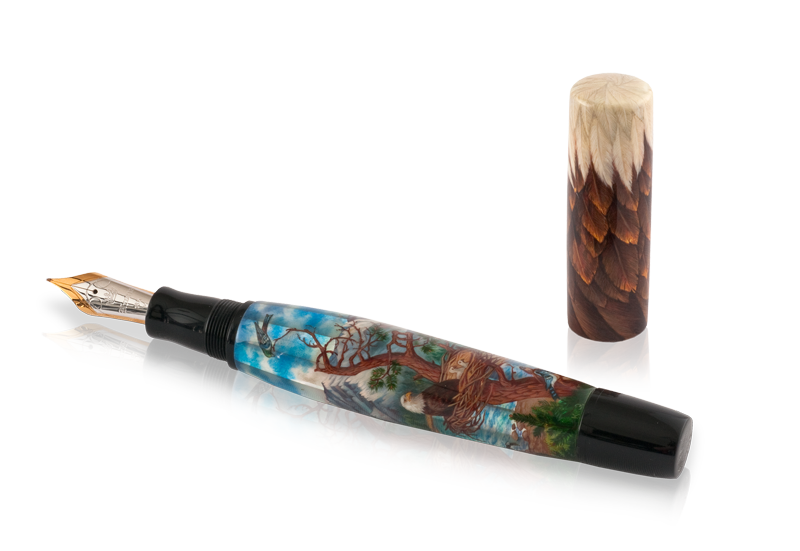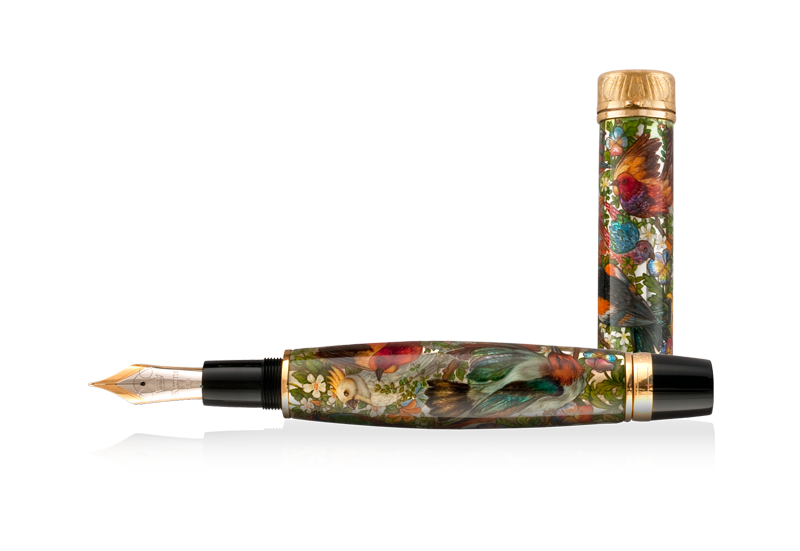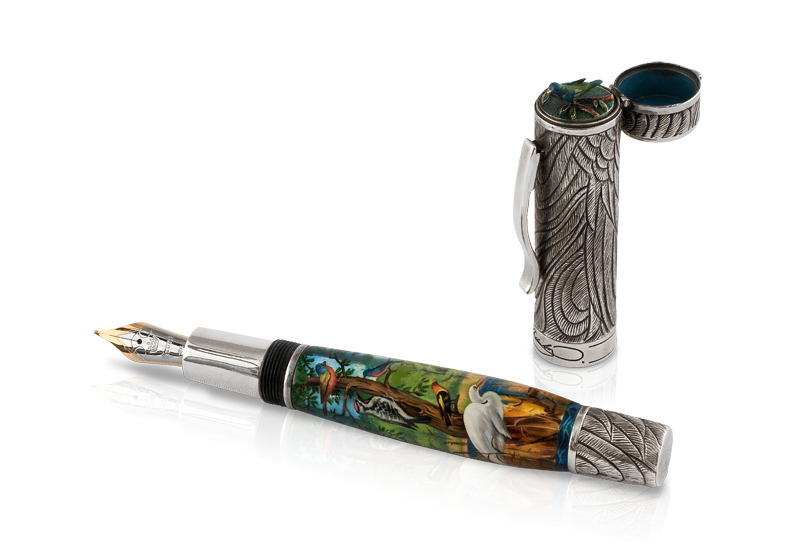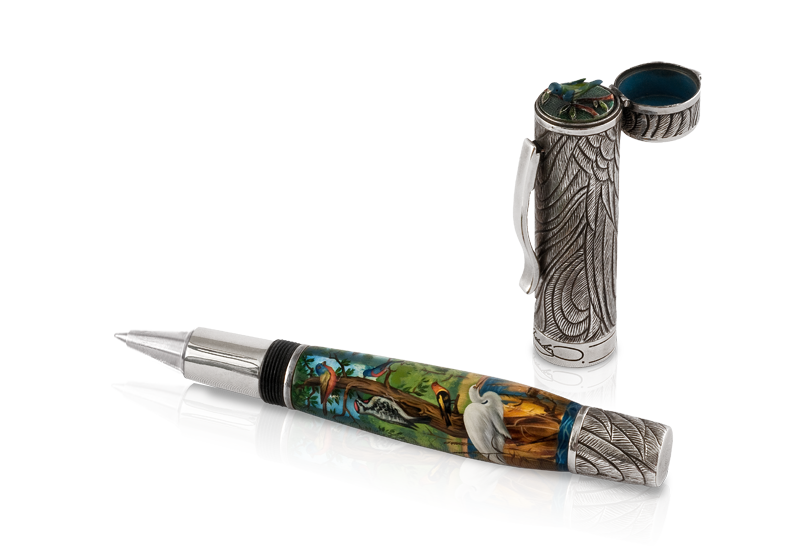There, amid the tall grass of the far-extended prairies of the West, in the solemn forests of the North, on the heights of the midland mountains, by the shores of the boundless ocean, and on the bosom of the vast lakes and magnificent rivers, have I sought to search out the things which have been hidden since the creation of the wondrous world, or seen only by the naked Indian, who has, for ages, dwelt in the gorgeous but melancholy wilderness.
John James Audubon--Ornithological Biography
At the outset of the 19th Century there was no established academic discipline of natural science in the United States. The vast majority of writing that had been done on the subject of American taxonomy had been done second-hand by European naturalists, most of who had never been to America or directly observed any North American animals or birds. Due to this lack of direct observation, most of the work and the accompanying conclusions were wrong. By the early 1800s, the only piece of writing on the subject of native taxonomy was Thomas Jefferson's Notes on Virginia, which laid the foundation for later work.
Young John James Audubon stepped into this scientific vacuum as a frontiersman who lacked formal education. Audubon's work and the publishing of his masterpiece, The Birds of America, would mark a great leap forward in the area of natural science. In his twenties and thirties he perpetually moved further west and south, getting deeper into the wilds of America and eventually settling near New Orleans. He ran a fairly successful dry goods store in Louisville, Kentucky for a number of years, but lost everything when he made a bad investment in a lumber mill. However, by his own admission, he much preferred hiking in the woods, studying, hunting and drawing birds. His business suffered in the process. After the mill failed, he made a living in many different ways: teacher, dance instructor, fiddler, fencing taxidermist, landscape painter and many other itinerant activities. But the constant thread in his life was his continued hiking in America's forests, shooting, skinning and painting the New World's birds. He literally walked thousands of miles. He was also an excellent marksman and sometimes shot more than 100 birds in a day. Without knowing it, he was inventing the American taxonomy described earlier by Jefferson, through direct observation of specimens in the wild. These observations yielded drawings and paintings that only a first-hand observer could produce, and therefore, were far more accurate and powerful than anything previously done on the subject.
His paintings were done to actual scale on double-wide elephant paper and they depicted dramatic scenes in natural habitats. He felt his work was superior to anything that had been done before and traveled to Philadelphia, the center of American intellectual tradition at the time, to gain recognition for his work. But his work was dismissed as gaudy and ridiculous by the arm-chair naturalists there, who defended the status quo to the hilt. Ironically, this rejection led him to England, where he found patrons and clients who were enthralled both by his work and his presence. He was the living embodiment of a handsome, strong Americanfrontiersman. The British made him a celebrity and published his work with enthusiasm. America's greatest naturalist had to go to England to find success.
John James Audubon died in New York City on January 27, 1851 at the age of 65. After he had completed what he referred to as his "great work", his health had started to slip. He was mentally and physically exhausted. By any measure, his contribution to the taxonomy of American birds was monumental, having catalogued over 440 species. Audubon was 54 years old when he completed The Birds of America and the accompanying Ornithological Biography.
Audubon's work has stood the test of time, and his contribution has been validated even more through the creation of the Audubon Society, an academic institution devoted to natural science. Nobody knows for sure how many complete sets of The Birds of America were made, but it certainly was fewer than 200. And they did appreciate in value over the years. The last time a full set of the elephant paper portfolio was sold, it fetched $8.8 million at auction.
SPECIFICATIONS
Krone celebrates John James Audubon and his passion for birds with a striking writing instrument.
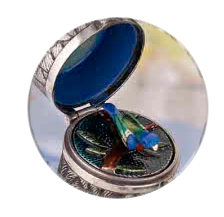 The .925 sterling silver cap and blind cap are etched in relief depicting highly detailed bird feathers. Hidden atop the cap is a special flip-top which opens to reveal a miniature hand painted three-dimensional Painted Bunting under a bright blue sky.
The .925 sterling silver cap and blind cap are etched in relief depicting highly detailed bird feathers. Hidden atop the cap is a special flip-top which opens to reveal a miniature hand painted three-dimensional Painted Bunting under a bright blue sky.
The slightly bulged shaped mother of pearl barrel is artfully painted with an array of Audubon’s birds in a tranquil outdoor setting.
A worldwide Limited Edition consisting of 188 Fountain Pens, 28 Rollerballs, 18 Magnum Fountain Pens dedicated to the Bald Eagle and 8 Imperial Fountain Pens.
Piston Fill. F, M and B.
There, amid the tall grass of the far-extended prairies of the West, in the solemn forests of the North, on the heights of the midland mountains, by the shores of the boundless ocean, and on the bosom of the vast lakes and magnificent rivers, have I sought to search out the things which have been hidden since the creation of the wondrous world, or seen only by the naked Indian, who has, for ages, dwelt in the gorgeous but melancholy wilderness.
John James Audubon--Ornithological Biography
At the outset of the 19th Century there was no established academic discipline of natural science in the United States. The vast majority of writing that had been done on the subject of American taxonomy had been done second-hand by European naturalists, most of who had never been to America or directly observed any North American animals or birds. Due to this lack of direct observation, most of the work and the accompanying conclusions were wrong. By the early 1800s, the only piece of writing on the subject of native taxonomy was Thomas Jefferson's Notes on Virginia, which laid the foundation for later work.
Young John James Audubon stepped into this scientific vacuum as a frontiersman who lacked formal education. Audubon's work and the publishing of his masterpiece, The Birds of America, would mark a great leap forward in the area of natural science. In his twenties and thirties he perpetually moved further west and south, getting deeper into the wilds of America and eventually settling near New Orleans. He ran a fairly successful dry goods store in Louisville, Kentucky for a number of years, but lost everything when he made a bad investment in a lumber mill. However, by his own admission, he much preferred hiking in the woods, studying, hunting and drawing birds. His business suffered in the process. After the mill failed, he made a living in many different ways: teacher, dance instructor, fiddler, fencing taxidermist, landscape painter and many other itinerant activities. But the constant thread in his life was his continued hiking in America's forests, shooting, skinning and painting the New World's birds. He literally walked thousands of miles. He was also an excellent marksman and sometimes shot more than 100 birds in a day. Without knowing it, he was inventing the American taxonomy described earlier by Jefferson, through direct observation of specimens in the wild. These observations yielded drawings and paintings that only a first-hand observer could produce, and therefore, were far more accurate and powerful than anything previously done on the subject.
His paintings were done to actual scale on double-wide elephant paper and they depicted dramatic scenes in natural habitats. He felt his work was superior to anything that had been done before and traveled to Philadelphia, the center of American intellectual tradition at the time, to gain recognition for his work. But his work was dismissed as gaudy and ridiculous by the arm-chair naturalists there, who defended the status quo to the hilt. Ironically, this rejection led him to England, where he found patrons and clients who were enthralled both by his work and his presence. He was the living embodiment of a handsome, strong Americanfrontiersman. The British made him a celebrity and published his work with enthusiasm. America's greatest naturalist had to go to England to find success.
John James Audubon died in New York City on January 27, 1851 at the age of 65. After he had completed what he referred to as his "great work", his health had started to slip. He was mentally and physically exhausted. By any measure, his contribution to the taxonomy of American birds was monumental, having catalogued over 440 species. Audubon was 54 years old when he completed The Birds of America and the accompanying Ornithological Biography.
Audubon's work has stood the test of time, and his contribution has been validated even more through the creation of the Audubon Society, an academic institution devoted to natural science. Nobody knows for sure how many complete sets of The Birds of America were made, but it certainly was fewer than 200. And they did appreciate in value over the years. The last time a full set of the elephant paper portfolio was sold, it fetched $8.8 million at auction.
SPECIFICATIONS
Krone celebrates John James Audubon and his passion for birds with a striking writing instrument.
 The .925 sterling silver cap and blind cap are etched in relief depicting highly detailed bird feathers. Hidden atop the cap is a special flip-top which opens to reveal a miniature hand painted three-dimensional Painted Bunting under a bright blue sky.
The .925 sterling silver cap and blind cap are etched in relief depicting highly detailed bird feathers. Hidden atop the cap is a special flip-top which opens to reveal a miniature hand painted three-dimensional Painted Bunting under a bright blue sky.
The slightly bulged shaped mother of pearl barrel is artfully painted with an array of Audubon’s birds in a tranquil outdoor setting.
A worldwide Limited Edition consisting of 188 Fountain Pens, 28 Rollerballs, 18 Magnum Fountain Pens dedicated to the Bald Eagle and 8 Imperial Fountain Pens. Piston Fill. F, M and B.
There, amid the tall grass of the far-extended prairies of the West, in the solemn forests of the North, on the heights of the midland mountains, by the shores of the boundless ocean, and on the bosom of the vast lakes and magnificent rivers, have I sought to search out the things which have been hidden since the creation of the wondrous world, or seen only by the naked Indian, who has, for ages, dwelt in the gorgeous but melancholy wilderness.
John James Audubon - Ornithological Biography
At the outset of the 19th Century there was no established academic discipline of natural science in the United States. The vast majority of writing that had been done on the subject of American taxonomy had been done second-hand by European naturalists, most of who had never been to America or directly observed any North American animals or birds. Due to this lack of direct observation, most of the work and the accompanying conclusions were wrong. By the early 1800s, the only piece of writing on the subject of native taxonomy was Thomas Jefferson's Notes on Virginia, which laid the foundation for later work.
Young John James Audubon stepped into this scientific vacuum as a frontiersman who lacked formal education. Audubon's work and the publishing of his masterpiece, The Birds of America, would mark a great leap forward in the area of natural science. In his twenties and thirties he perpetually moved further west and south, getting deeper into the wilds of America and eventually settling near New Orleans. He ran a fairly successful dry goods store in Louisville, Kentucky for a number of years, but lost everything when he made a bad investment in a lumber mill. However, by his own admission, he much preferred hiking in the woods, studying, hunting and drawing birds. His business suffered in the process. After the mill failed, he made a living in many different ways: teacher, dance instructor, fiddler, fencing taxidermist, landscape painter and many other itinerant activities. But the constant thread in his life was his continued hiking in America's forests, shooting, skinning and painting the New World's birds. He literally walked thousands of miles. He was also an excellent marksman and sometimes shot more than 100 birds in a day. Without knowing it, he was inventing the American taxonomy described earlier by Jefferson, through direct observation of specimens in the wild. These observations yielded drawings and paintings that only a first-hand observer could produce, and therefore, were far more accurate and powerful than anything previously done on the subject.
His paintings were done to actual scale on double-wide elephant paper and they depicted dramatic scenes in natural habitats. He felt his work was superior to anything that had been done before and traveled to Philadelphia, the center of American intellectual tradition at the time, to gain recognition for his work. But his work was dismissed as gaudy and ridiculous by the arm-chair naturalists there, who defended the status quo to the hilt. Ironically, this rejection led him to England, where he found patrons and clients who were enthralled both by his work and his presence. He was the living embodiment of a handsome, strong Americanfrontiersman. The British made him a celebrity and published his work with enthusiasm. America's greatest naturalist had to go to England to find success.
John James Audubon died in New York City on January 27, 1851 at the age of 65. After he had completed what he referred to as his "great work", his health had started to slip. He was mentally and physically exhausted. By any measure, his contribution to the taxonomy of American birds was monumental, having catalogued over 440 species. Audubon was 54 years old when he completed The Birds of America and the accompanying Ornithological Biography.
Audubon's work has stood the test of time, and his contribution has been validated even more through the creation of the Audubon Society, an academic institution devoted to natural science. Nobody knows for sure how many complete sets of The Birds of America were made, but it certainly was fewer than 200. And they did appreciate in value over the years. The last time a full set of the elephant paper portfolio was sold, it fetched $8.8 million at auction.
SPECIFICATIONS
Krone celebrates John James Audubon and his passion for birds with a striking writing instrument.
 The .925 sterling silver cap and blind cap are etched in relief depicting highly detailed bird feathers. Hidden atop the cap is a special flip-top which opens to reveal a miniature hand painted three-dimensional Painted Bunting under a bright blue sky.
The .925 sterling silver cap and blind cap are etched in relief depicting highly detailed bird feathers. Hidden atop the cap is a special flip-top which opens to reveal a miniature hand painted three-dimensional Painted Bunting under a bright blue sky.
The slightly bulged shaped mother of pearl barrel is artfully painted with an array of Audubon’s birds in a tranquil outdoor setting.
A worldwide Limited Edition consisting of 188 Fountain Pens, 28 Rollerballs, 18 Magnum Fountain Pens dedicated to the Bald Eagle and 8 Imperial Fountain Pens.
Piston Fill. F, M and B.
There, amid the tall grass of the far-extended prairies of the West, in the solemn forests of the North, on the heights of the midland mountains, by the shores of the boundless ocean, and on the bosom of the vast lakes and magnificent rivers, have I sought to search out the things which have been hidden since the creation of the wondrous world, or seen only by the naked Indian, who has, for ages, dwelt in the gorgeous but melancholy wilderness.
John James Audubon--Ornithological Biography
At the outset of the 19th Century there was no established academic discipline of natural science in the United States. The vast majority of writing that had been done on the subject of American taxonomy had been done second-hand by European naturalists, most of who had never been to America or directly observed any North American animals or birds. Due to this lack of direct observation, most of the work and the accompanying conclusions were wrong. By the early 1800s, the only piece of writing on the subject of native taxonomy was Thomas Jefferson's Notes on Virginia, which laid the foundation for later work.
Young John James Audubon stepped into this scientific vacuum as a frontiersman who lacked formal education. Audubon's work and the publishing of his masterpiece, The Birds of America, would mark a great leap forward in the area of natural science. In his twenties and thirties he perpetually moved further west and south, getting deeper into the wilds of America and eventually settling near New Orleans. He ran a fairly successful dry goods store in Louisville, Kentucky for a number of years, but lost everything when he made a bad investment in a lumber mill. However, by his own admission, he much preferred hiking in the woods, studying, hunting and drawing birds. His business suffered in the process. After the mill failed, he made a living in many different ways: teacher, dance instructor, fiddler, fencing taxidermist, landscape painter and many other itinerant activities. But the constant thread in his life was his continued hiking in America's forests, shooting, skinning and painting the New World's birds. He literally walked thousands of miles. He was also an excellent marksman and sometimes shot more than 100 birds in a day. Without knowing it, he was inventing the American taxonomy described earlier by Jefferson, through direct observation of specimens in the wild. These observations yielded drawings and paintings that only a first-hand observer could produce, and therefore, were far more accurate and powerful than anything previously done on the subject.
His paintings were done to actual scale on double-wide elephant paper and they depicted dramatic scenes in natural habitats. He felt his work was superior to anything that had been done before and traveled to Philadelphia, the center of American intellectual tradition at the time, to gain recognition for his work. But his work was dismissed as gaudy and ridiculous by the arm-chair naturalists there, who defended the status quo to the hilt. Ironically, this rejection led him to England, where he found patrons and clients who were enthralled both by his work and his presence. He was the living embodiment of a handsome, strong Americanfrontiersman. The British made him a celebrity and published his work with enthusiasm. America's greatest naturalist had to go to England to find success.
John James Audubon died in New York City on January 27, 1851 at the age of 65. After he had completed what he referred to as his "great work", his health had started to slip. He was mentally and physically exhausted. By any measure, his contribution to the taxonomy of American birds was monumental, having catalogued over 440 species. Audubon was 54 years old when he completed The Birds of America and the accompanying Ornithological Biography.
Audubon's work has stood the test of time, and his contribution has been validated even more through the creation of the Audubon Society, an academic institution devoted to natural science. Nobody knows for sure how many complete sets of The Birds of America were made, but it certainly was fewer than 200. And they did appreciate in value over the years. The last time a full set of the elephant paper portfolio was sold, it fetched $8.8 million at auction.
SPECIFICATIONS
Krone celebrates John James Audubon and his passion for birds with a striking writing instrument.
 The .925 sterling silver cap and blind cap are etched in relief depicting highly detailed bird feathers. Hidden atop the cap is a special flip-top which opens to reveal a miniature hand painted three-dimensional Painted Bunting under a bright blue sky.
The .925 sterling silver cap and blind cap are etched in relief depicting highly detailed bird feathers. Hidden atop the cap is a special flip-top which opens to reveal a miniature hand painted three-dimensional Painted Bunting under a bright blue sky.
The slightly bulged shaped mother of pearl barrel is artfully painted with an array of Audubon’s birds in a tranquil outdoor setting.
A worldwide Limited Edition consisting of 188 Fountain Pens, 28 Rollerballs, 18 Magnum Fountain Pens dedicated to the Bald Eagle and 8 Imperial Fountain Pens. Piston Fill. F, M and B.
 The .925 sterling silver cap and blind cap are etched in relief depicting highly detailed bird feathers. Hidden atop the cap is a special flip-top which opens to reveal a miniature hand painted three-dimensional Painted Bunting under a bright blue sky.
The .925 sterling silver cap and blind cap are etched in relief depicting highly detailed bird feathers. Hidden atop the cap is a special flip-top which opens to reveal a miniature hand painted three-dimensional Painted Bunting under a bright blue sky. The .925 sterling silver cap and blind cap are etched in relief depicting highly detailed bird feathers. Hidden atop the cap is a special flip-top which opens to reveal a miniature hand painted three-dimensional Painted Bunting under a bright blue sky.
The .925 sterling silver cap and blind cap are etched in relief depicting highly detailed bird feathers. Hidden atop the cap is a special flip-top which opens to reveal a miniature hand painted three-dimensional Painted Bunting under a bright blue sky. The .925 sterling silver cap and blind cap are etched in relief depicting highly detailed bird feathers. Hidden atop the cap is a special flip-top which opens to reveal a miniature hand painted three-dimensional Painted Bunting under a bright blue sky.
The .925 sterling silver cap and blind cap are etched in relief depicting highly detailed bird feathers. Hidden atop the cap is a special flip-top which opens to reveal a miniature hand painted three-dimensional Painted Bunting under a bright blue sky. The .925 sterling silver cap and blind cap are etched in relief depicting highly detailed bird feathers. Hidden atop the cap is a special flip-top which opens to reveal a miniature hand painted three-dimensional Painted Bunting under a bright blue sky.
The .925 sterling silver cap and blind cap are etched in relief depicting highly detailed bird feathers. Hidden atop the cap is a special flip-top which opens to reveal a miniature hand painted three-dimensional Painted Bunting under a bright blue sky.
